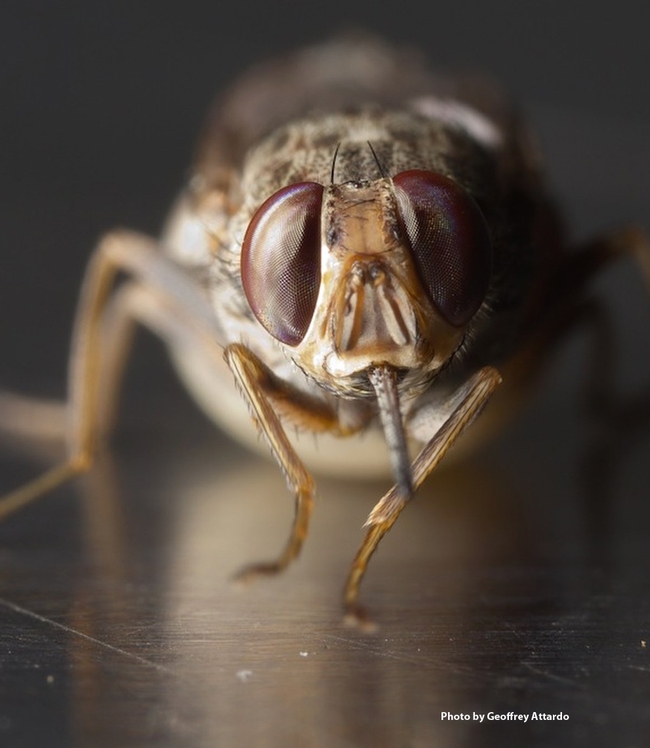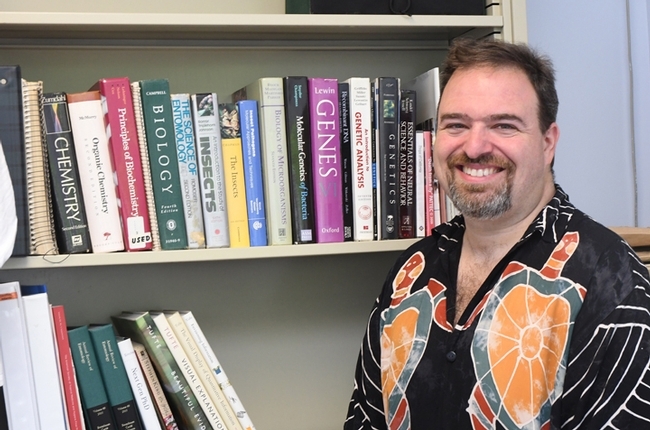- Author: Kathy Keatley Garvey
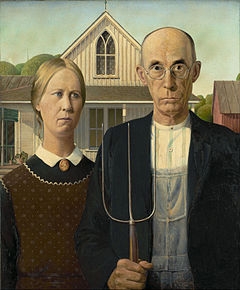
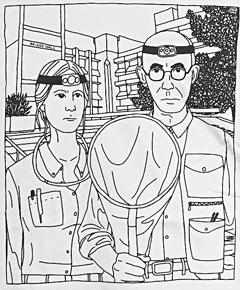
When the 105th annual UC Davis Picnic Day takes place Saturday, April 13, thousands of visitors will explore the campus. It promises to be informative, educational and entertaining.
But over at Briggs Hall, home of the UC Davis Department of Entomology and Nermatology, “special guests” will include bugs.
There will not only be cockroach races, maggot art, and displays of bees, ants, aquatic insects—and more!—but huge images of vectors, the incredible macro photography of medical entomologist/geneticist Geoffrey Attardo, assistant professor, UC Davis Department of Entomology and Nematology.
Virtual Reality Bugs
Attardo will be demonstrating “Virtual Reality Bugs” where youths and adults can watch 40-foot tall, three-dimensional insects and spiders. And in his medical entomology display, he will be exhibiting metal prints of vectors, including a tsetse fly, kissing bug, deer tick, mosquito, stable fly, cat flea and bed bug.
You wouldn't want to encounter a bed bug in your bed, or a flea or tick on your dog, or a mosquito on your arm. You may not even know what they look like up close. But with these images, you can see what's bugging you or your pets.
And with the Virtual Reality Bugs, participants can select what they want to see--or what's towering over them. The list includes a black widow spider, ant, beetle, grasshopper, damsel fly, cicada, cockroach, and a tsetse fly. Each person will be limited to about 30 seconds to accommodate the crowd.
The Briggs Hall activities run from 9 a.m. to about 4:30, while activities at the Bohart Museum of Entomology, will be offered from 11 a.m. to 2 p.m.
TheBohart Museum will focus on the theme, "Will Travel for Bugs: TheBohart Museum of Entomology's Collections from Around the World." It's nominated for a people's choice award, as is the honey tasting exhibit at Briggs Hall. Participants will sample meadowfoam, sage, cotton and buckwheat. QR codes will be at each site. (See news story about the activities at both sites.)
Vectors
But back to the vectors. Did you know that the Bohart Museum provides information or fact sheets on its website at http://bohart.ucdavis.edu/insect-info-sheets.html?
You can learn about some of the vectors that will dwarf you when you visit Briggs Hall.
For example, ticks!
"Ticks are blood-feeding external parasites of mammals, birds, and reptiles throughout the world," writes Lynn Kimsey, director of the Bohart Museum and UC Davis professor of entomology. "They are not insects rather they are arachnids, the same group that includes spiders and scorpions. There are two different groups of ticks, the hard ticks (Ixodidae) and soft ticks (Argasidae). Both are important vectors of pathogens to humans and animals throughout the world. Some diseases of current interest in the United States caused by tick-borne pathogens include Lyme Disease, Rocky Mountain Spotted Fever, and tick-borne Relapsing Fever (soft ticks)
"Many ticks seek hosts by 'questing.' Questing ticks crawl up the stems of grass or perch on the edges of leaves in a typical posture with the front legs extended. Certain chemicals, such as CO2, as well as heat and movement cause questing behavior. Ticks climb onto a potential host that brushes against their extended front legs. Once on a host hard ticks may feed for several days to several weeks.
And fleas!
"Fleas are bloodsucking parasites of humans, livestock and pets," Kimsey writes. "Only adult fleas feed on blood, which they obtain with their piercing/sucking mouthparts. Adult fleas blood feed on birds and mammals.Adult fleas are laterally flattened, wingless insects. They have a small eye spot on the side of the head, and a row of stout spines along the side of the head and the back of the thorax. Adult fleas travel rapidly by jumping, using their legs and a spring-like mechanism in the body. They are capable of spectacular leaps, covering distances up to one hundred times their body length
"The most common flea found on household pets, such as cats and dogs, is the cat flea, Xenopsylla cheopis."
Read the Bohart fact sheets and then check out Attardo's images.
EGSA T-Shirts
If you'd rather wear your bug on your shirt, the Entomology Graduate Student Association (EGSA) can oblige. They have scores of insect-themed t-shirts, ranging from beetles and honey bees to wanna bees. The newest t-shirts in the line-up include two designed by talented doctoral student/ant specialist Jill Oberski of the Phil Ward lab. One is a take-off of American Gothic, the 1930 painting by Grant Wood, except with entomologists holding a net in front of Briggs Hall, UC Davis campus, instead of the farmers holding a pitchfork in front of their farmhouse. The other Oberski t-shirt celebrates the 45th anniversary of UC Davis Picnic Day cockroach races. Roaches rock! Forensic entomologist Robert Kimsey, co-chair of the department's displays at Picnic Day, rears cockroaches in his lab, but on Picnic Day, they're ready to race! Doctoral candidate Brendon Boudinot, EGSA president and co-chair of the department's displays, says the roaches will race on a new racetrack.
Doctoral student/nematologist Corwin Parker of the lab of Steve Nadler, professor and chair of the UC Davis Department of Entomology and Nematology, also came up with a clever idea for a t-shirt. You know how cicadas can be REALLY loud? He drew one plugged into an amp. Now, that's REALLY loud! You can buy EGSA t-shirts at Briggs Hall on Picnic Day or order them online at https://mkt.com/UCDavisEntGrad/ after Picnic Day.
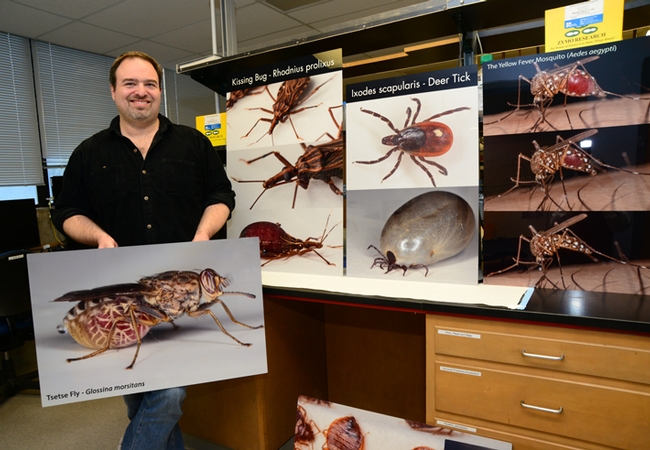
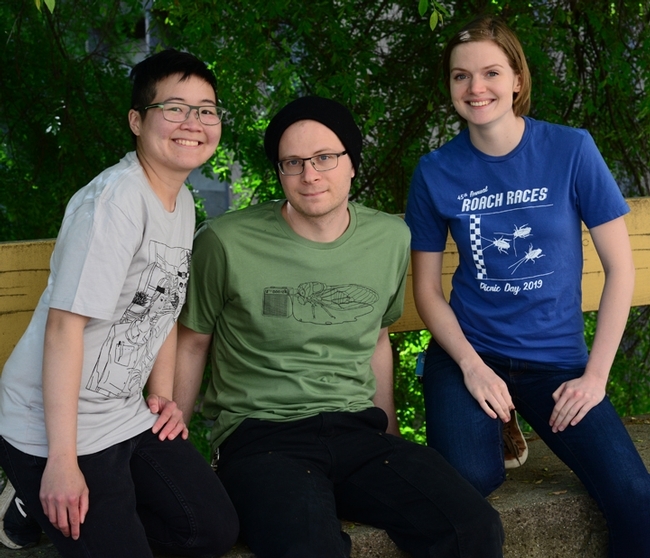
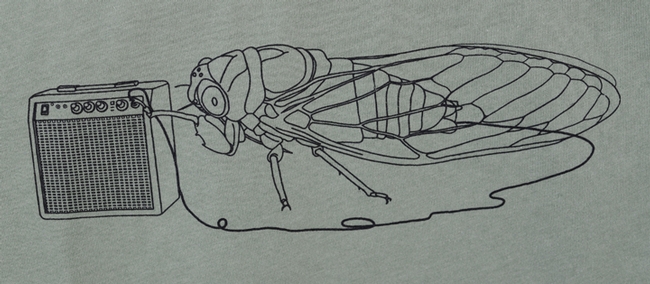
- Author: Kathy Keatley Garvey
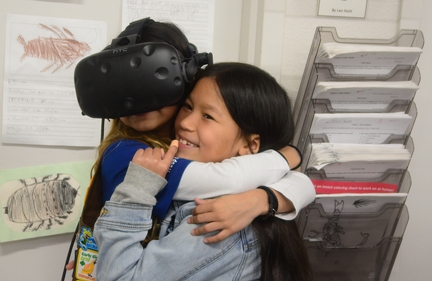
Be sure to head over to Briggs Hall on Saturday, April 13 during the 105th annual UC Davis Picnic Day to see or participate in medical entomologist/geneticist Geoffrey Attardo's virtual reality (VR) demonstration. It's free and family friendly.
Attardo describes VR as a "computer-generated simulation used to simulate real or imagined environments. It immerses the user by stimulating visual, auditory and touch-based senses."
In other words, VR is an interactive, three-dimensional, computer-generated experience. You'll enter the fascinating, breathtaking world of insects and arthropods on a scale you've never before imagined. Tiny critters that are easy to overlook can't be overlooked in the VR world.
Attardo, an assistant professor in the Department of Entomology and Nematology, drew crowds all day long at last year's "Virtual Reality Bugs" at UC Davis Picnic Day, and no doubt he'll do so again. Briggs Hall activities begin at 9 a.m. and conclude around 4:30.
Attardo presented a seminar titled "Using Virtual Reality to Engage and Instruct: a A Novel Tool for Outreach and Extension," at the 2018 Entomological Society of America (ESA) meeting in Vancouver, B.C.
"Recent developments in computer and display technologies are providing novel ways to interact with information," he told the ESA attendees. "One of these innovations is the development of Virtual Reality (VR) hardware. Innovations in hardware and software have made this technology broadly accessible with options ranging from cell phone based VR kits made of cardboard to dedicated headsets driven by computers using powerful graphical hardware. VR based educational experiences provide opportunities to present content in a form where they are experienced in 3 dimensions and are interactive."
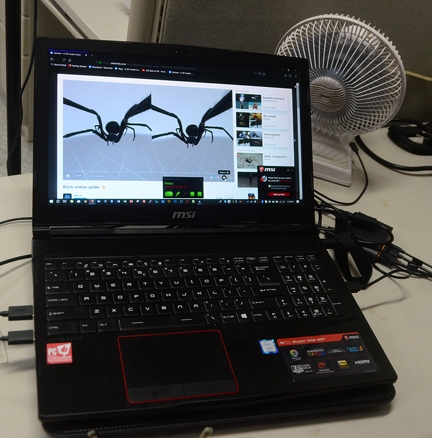
Attardo says that "VR has great potential as a new way to present entomological content including aspects of morphology, physiology, behavior and other aspects of insect biology. This demonstration allows users of all ages to view static and animated 3D models of insects and arthropods in virtual reality."
The system he uses? A HTC Vive driven by a VR ready laptop. You can see his three-dimensional insect models on Sketchfab.com, using the Firefox web browser. In addition, you can view the models in two dimensions on any computer with most web browsers.
In his presentation to ESA, Attardo commented: "This isn't your parents' virtual reality! Early computers and monitors could not produce the frame rate/resolution required. Early attempts at VR were heavy, awkward and motion-sickness inducing. Increased processing power, smaller computers and high resolution screens have solved these issues."
How does VR work? For software, you need a graphical engine to build a world, content for inclusion in the world, and interactivity, with the world responding to the user via artificial intelligence. You need headsets, your windows into the virtual world. Controls assist the user in interacting with the world.
Attardo says that VR can be used for surgical training, data visualization, engineering, and "making big things small and small things big." It can also be used for physical and psychological therapy, such as evaluation of cognitive function in Alzheimer's patients, anxiety reduction in dementia patients, reduction in pre-surgery anxiety,post-traumatic stress disorder (PTSD) therapy, and reduction in pain associated with dental procedures.
How can VR be used in education? At the ESA meeting, the UC Davis faculty member listed these six educational benefits:
- Reduces or eliminates distractions
- Experienced-based learning
- VR-based experiences facilitate better recall due to spatial associations
- Content is interactive and explorable at the student's pace
- Visual classrooms allow long-distance learning
- Engaging
He attributed "better recall to spatial associations" to a research paper, Virtual Memory Palaces: Immersion Aids Recall, by E. Krokos, et al., published in 2018 in Virtual Reality.
Yes, there are some negatives along with the positives. The system can be expensive, you can encounter potential technical issues, it's limited to available content, and you'll need multiple sets of hardware. Plus, content development software has a steep learning curve, he said.
Attardo joined the UC Davis Department of Entomology and Nematology in 2017 from Yale University School of Public Health, New Haven, Conn., where he served as a research scientist. A native of Poughkeepsie, N.Y., he received a bachelor's degree in entomology from the University of Massachusetts, Amherst, in 1994 and his doctorate in genetics from Michigan State University, East Lansing, in 2004.
At UC Davis, his lab focuses on aspects of the physiology of tsetse fly reproduction.
“As a scientist, I have taken my fascination with the magnifying things to the extreme in that my work tends to focus on the molecular biology underlying the physiology of insect adaptations," he told us in a 2017 interview. "The molecular adaptations are just as amazing as the morphological ones. However, they are even harder to visualize and explain to lay people. I enjoy illustration and artwork as well, so when it is not possible to take a picture of something I am working on, I try to create a visual representation of it.”
“I also really enjoy digital illustration and have recently gotten into 3D modeling. My first model is a tsetse fly for which I was able to use my macro photos to texture." See https://sketchfab.com/models/263750e5a9c54c56a77d63ac06f2f317
Attardo demonstrated his system at a recent Bohart Museum of Entomology open house, where participants of all ages engaged with three-dimensional gigantic spiders. Several members of a Brownie Girl Scout Troop from Vacaville giggled and held on to each other. Lynn Kimsey, director of the Bohart Museum, looked at the spiders, looked at them and said "I just want to collect them!"
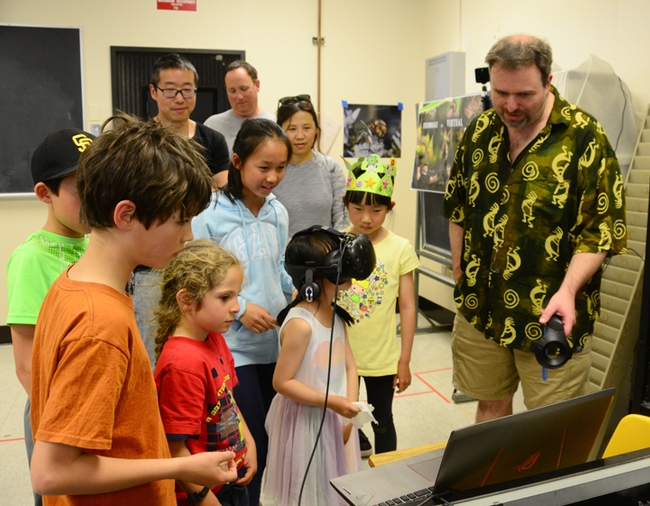
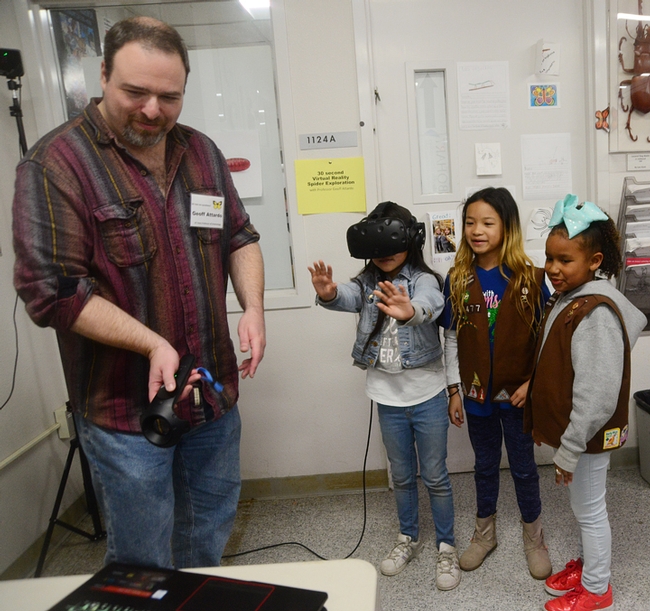
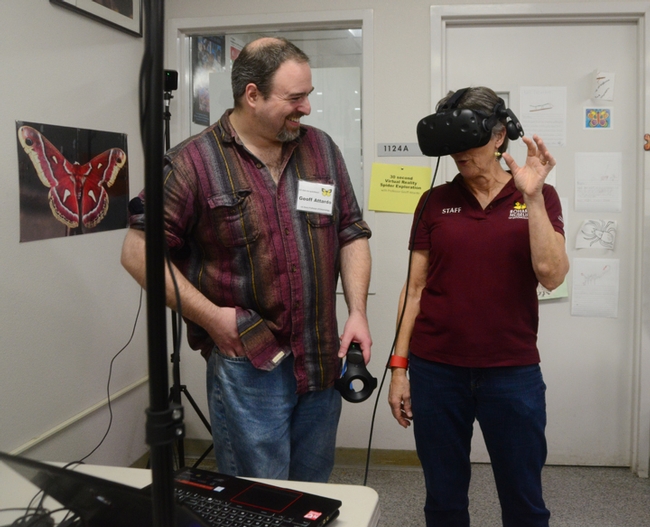
- Author: Kathy Keatley Garvey

They range in topics from fruit flies to spider glue to an African odysssey.
The seminars take place at 4 p.m. every Wednesday in Room 122 of Briggs Hall, beginning April 3 and ending June 5.
The schedule:
Wednesday, April 3
Alistair McGregor, Oxford Brookes University, England
Topic: "Differences in Tartan Underlie the Evolution of Male Genital Morphology Between Drosophila Species"
Host: Geoffrey Attardo, assistant professor, UC Davis Department of Entomology and Nematology
Wednesday, April 10
Monique Rivera, UC Riverside
Topic: "How Agriculture Influences the Structure of Belowground Communities"
Host: Elvira de Lange, postdoctoral fellow, UC Davis Department of Entomology and Nematology"
Wednesday, April 17
Bert Hölldobler, Arizona State University
Topic: "The Superorganism: Communication, Cooperation and Conflict in Ant Societies"
Host: Robert Page, distinguished emeritus professor, UC Davis Department of Entomology and Nematology and provost emeritus, Arizona State University
Wednesday, April 24
Sarah Stellwagen, University of Maryland
Topic: "Towards Spider Glue: From Material Properties to Sequencing the Longest Silk Family Gene" (Link)
Hosts: Hanna Kahl, doctoral student in entomology, and Jason Bond, the Evert and Marion Schlinger Endowed Chair in Insect Systematics, UC Davis Department of Entomology and Nematology
Wednesday, May 1
Andrew Nuss, University of Nevada, Reno
Topic: "Breaking Insecticide Resistance: Novel Strategies for Insect Pest Management"
Host: Geoffrey Attardo, assistant professor, UC Davis Department of Entomology and Nematology
Wednesday, May 8
Colin Orians, Tuffs University, Massachussetts
Topic: "Mitigating the Effects of Climate Change on Tea Agroecosystems in China"
Host: Rachel Vannette, assistant professor, UC Davis Department of Entomology and Nematology
Wednesday, May 15
Erin Wilson-Rankin, UC Riverside
Topic: "Ecological Factors Underlying Diet Shifts in California Pollinators"
Host: Rachel Vannette, assistant professor, UC Davis Department of Entomology and Nematology
Wednesday, May 22
James R. Carey, distinguished professor of entomology, UC Davis Department of Entomology and Nematology
Topic: African Odyssey: Natural Wonders, Wildlife Adventures, and Indigenous Peoples"
Wednesday, May 29
Laurence Packer, York University, Canada
Topic: "Extreme Bees in Extreme Environments: Bee Biogeography in the Atacama Desert"
Hosts: Leslie Saul-Gershenz, associate director of research, Wild Energy Initiative, John Muir Institute of the Environment, UC Davis, and Steve Nadler, professor and chair, UC Davis Department of Entomology and Nematology
Wednesday, June 5
Immo Hansen, New Mexico State University
Topic: "Toward Implementation of Mosquito Sterile Insect Technique"
Host: Geoffrey Attardo, assistant professor, UC Davis Department of Entomology and Nematology
More information is available from Attardo at gmattardo@ucdavis.edu.
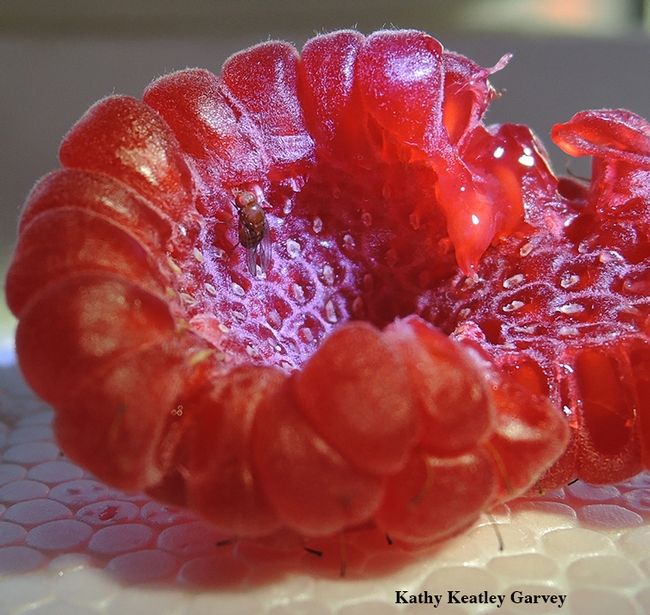
- Author: Kathy Keatley Garvey
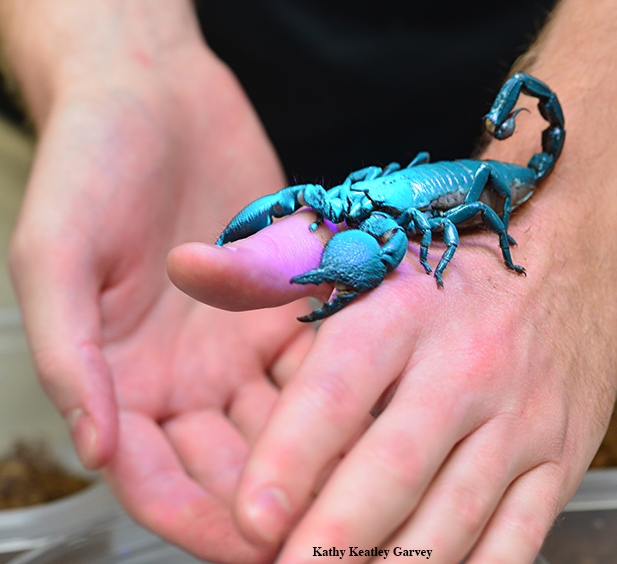
But did you know that scorpions are the oldest living terrestrial arthropods on the planet--that they're approximately 400 million years old? And that these "living fossils" were here before the dinosaurs?
And, did you also know that scorpions are the only arachnids that give birth to live young?
All fascinating facts.
Scorpion scientist Lauren Esposito of the California Academy of Sciences, will reveal those facts--and much more--when she discusses her research at the UC Davis Department of Entomology and Nematology seminar on Wednesday, Feb. 27.
Esposito, assistant curator and Schlinger chair of Arachnology at the California Academy of Sciences, San Francisco, will speak on "Evolution of New World Scorpions and Their Venom" from 4:10 to 5 p.m. in 122 Briggs Hall. Host is Jason Bond, Evert and Marion Schlinger Endowed Chair in Insect Systematics, UC Davis Department of Entomology and Nematology.
Scorpions are just about everywhere; they're found on every continent except Antarctica. In fact, they're found in every ecosystem on the planet, from cave systems below sea level to the peaks of the Alps and the Andes, Esposito says. Although scientists have described 2,200 species of scorpions, Esposito estimates that this number encompasses only 60 percent of the group's total diversity. In her research, she's trying to fill in that taxonomic gap.
Scorpions first drew Esposito's interest in her childhood. Both her parents are biologists. She remembers visiting her grandparents on a remote island in the Bahamas. “The most dangerous things on the island were ants and scorpions, so it was a pretty ideal place for a child to explore,” she quips on the Cal Academy website.
Esposito served a summer undergraduate internship in arachnology at the American Museum of Natural History (AMNH), and did volunteer work at a field station in the Chihuahuan Desert. She returned to AMNH to complete her doctorate in arachnology, and then completed a postdoctoral fellowship studying the biogreography of scorpions in the Caribbean. In 2015, she accepted an arachnologist position at the Cal Academy.
"For the past several years, Esposito has studied the evolution and geographical distribution of scorpions in the Caribbean," according to the Cal Academy website. "She suspects the string of islands played a significant but underappreciated role in producing the biodiversity currently found in North and South America. Because scorpions are essentially 'living fossils,' they're ideal organisms to study to decipher this larger relationship. Understanding the biodiversity of this region in a time of rapid agricultural development is a key step toward sustaining it for sustaining it for future generations."
Esposito marvels that a single scorpion "can carry the genes for more than 200 unique venoms in its DNA." She describes those venom varieties as "like protein cocktails, mixed to affect specific mammals, insects, and crustaceans."
“Researchers think that scorpions eject venoms with different compositions depending on the scenario," she says. "If they encounter a predator, they'll eject one combination, and if they encounter prey, a different one.” The venom's effects? Pain, temporary paralysis, or death.
Esposito focuses her research on the evolution of scorpion venom alongside the evolution of scorpions. This makes her unique among venom experts, who are often toxicologists or biochemists studying its chemistry, according to the Cal Academy website.
“Looking at how this venom diversity evolved helps us understand how one creature can evolve the ability to strike hundreds of specific targets,” explains Esposito. “There's a kind of evolutionary arms race happening between scorpions and mammals, particularly with predatory, nocturnal scorpion mice.”
Cal Academy's YouTube video on The Anamolies: Venom Race points out that although "the stings of most scorpions are harmless to humans, a select few can be fatal. Striped bark scorpions, a group of species found in the southwestern U.S. and northern Mexico, inflict on average 100,000 stings and, until recently, caused more than a thousand deaths each year in Mexico alone. While finding a treatment to this public health concern has been a driving force behind studies of bark scorpion venom, there was one very basic question that had scientists scratching their heads: Why and how would such a tiny creature pack such a lethal punch? Now, researchers, including Lauren Esposito, curator of Arachnology at the California Academy of Sciences, think they've found the answers in the interplay between a diminutive but dauntless predator—a mouse that has a particular taste for these venomous invertebrates—and the scorpions' own genetic makeup."
Check out these other incredible videos on the Cal Academy website:
Medical entomologist Geoffrey Attardo, assistant professor, UC Davis Department of Entomology and Nematology, coordinates the weekly seminars.
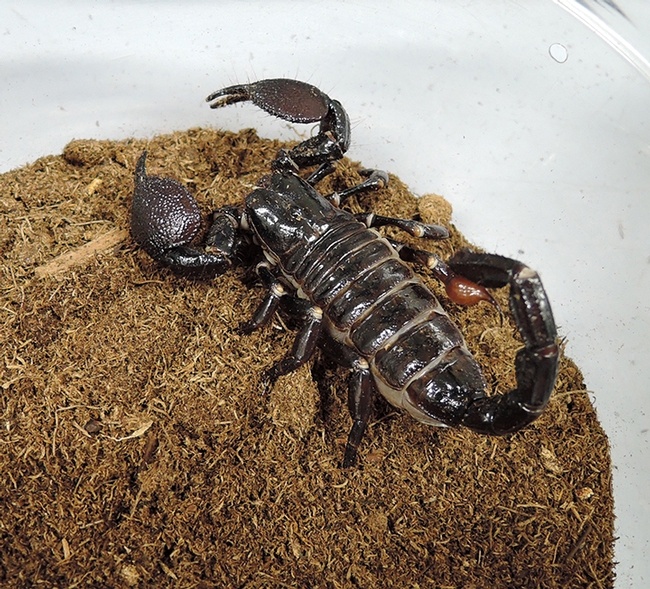
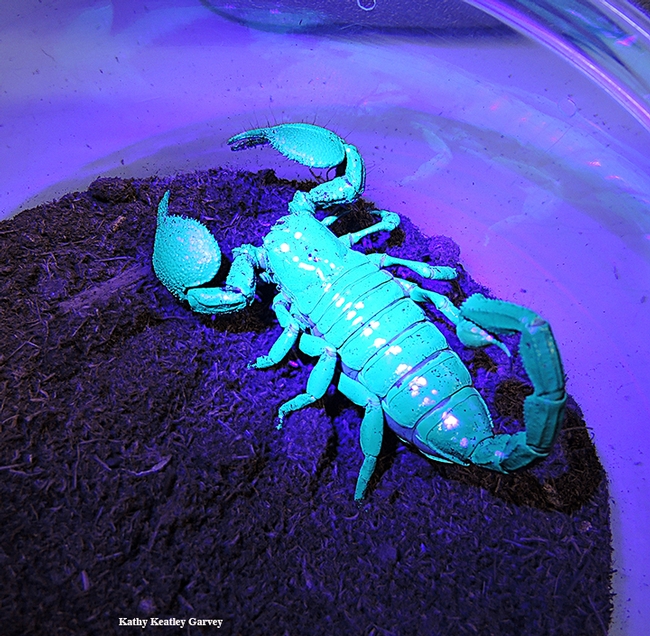
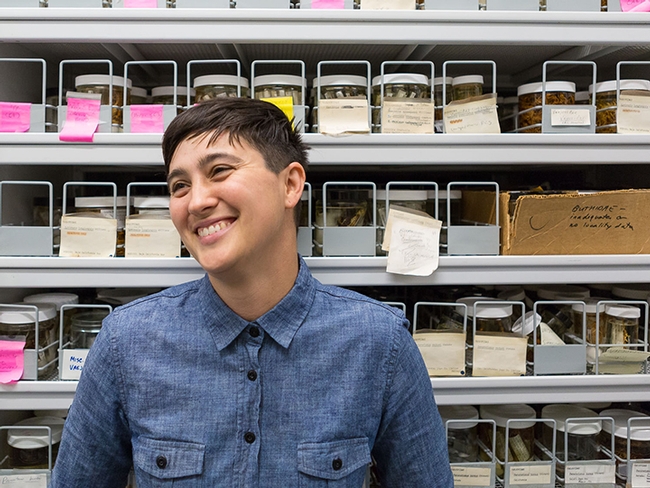
- Author: Kathy Keatley Garvey
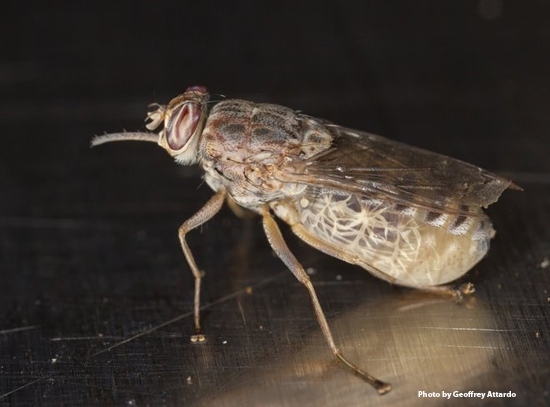
Totally fascinating.
Tsetse fly expert Geoffrey Attardo, a medical entomologist and assistant professor with the UC Davis Department of Entomology and Nematology, drew the attention of Pulitzer-Prize winning science writer Natalie Angier who penned the article, "Everywhere in the Animal Kingdom, Followers of the Milky Way" (subhead: "As scientists learn more about milk's evolution and compositional variations, they are redefining what used to be a signature characteristic of mammals.")
Her lede: "Most female flies take a low-rent approach to parenthood, depositing scores of seed-sized eggs in the trash or on pet scat to hatch, leaving the larvae to fend for themselves."
"Not so the female tsetse fly. She gestates her young internally, one at a time, and gives birth to them live. When each extravagantly pampered offspring pulls free of her uterus after nine days, fly mother and child are pretty much the same size."
Then she quoted the UC Davis medical entomologist:
“It's the equivalent of giving birth to an 18-year-old,” said Geoffrey Attardo, an entomologist who studies tsetse flies at the University of California, Davis.
Attardo focuses his research on numerous aspects of the physiology of tsetse fly reproduction, with the goal to identify and understand key aspects of its reproductive biology. He joined the UC Davis Department of Entomology and Nematology in 2017 from tje Yale University School of Public Health, New Haven, Conn., where he researched tsetse flies in the lab of Serap Aksoy.
In terms of "fascinating physiological adaptations," Attardo considers the tsetse fly "one of the champions of the insect world!" As he explained to us in a 2017 news story: "In addition to being vectors of a deadly disease, Trypanosomiasis, these flies have undergone amazing alterations to their physiology relative to other insects. Some examples of this are their ability feed exclusively on blood, their obligate relationship with a bacterial symbiont, the fact that they lactate and that they give birth to fully developed larval offspring."
"The opportunity to study the adaptations these flies have made is like opening a toy chest for an insect physiologist. My work in tsetse has focused on the molecular biology underlying the adaptations associated with the development of lactation, symbiosis, male and female mating interactions/physiology and nutrient metabolism and mobilization.”
Attardo's published research is drawing national and international attention, as are his incredible images of tsetse flies. He won the 2010 Fogarty Grantee Photo Contest with an image of a tsetse fly. The Yale School of Public Health magazine featured his images on “An Eye for the Tsetse Fly.” The Los Angeles Times published his remarkable video (in 2014) of a tsetse fly giving birth. Also, see his portraits of the tsetse fly on Live Science, published in 2014.
In her New York Times article, Angier points out that "Only in the class Mammalia do all member species nurse their young, yet evolutionary biologists now believe that the roots of mammalian lactation date back more than 300 million years, a good 100 million years before the first mammals appeared."
Who knew?
And while on the subject of tsetse flies, be sure to read the September 2016 article, "Tsetse Flies Are Strange and Dangerous," by Kevin Fitzgerald in Entomology Today, a publication of the Entomological Society of America. Fitzgerald featured the work of Attardo and posted one of his photos.
